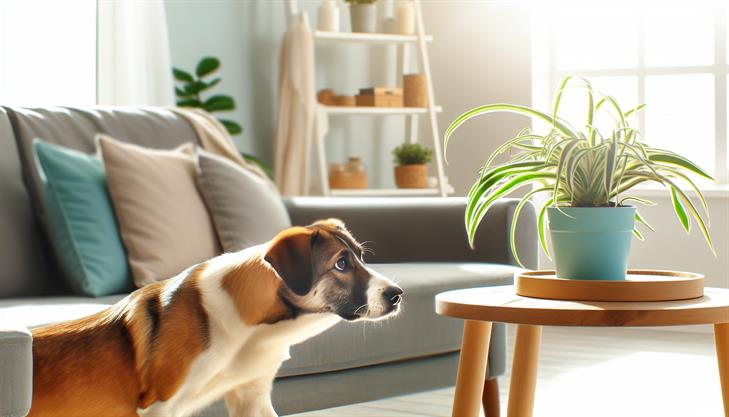As pet owners, there’s nothing more precious than the safety and well-being of our furry companions. Whether they’re eagerly wagging their tails or napping at our feet, dogs are treasured family members who deserve a safe environment. One question that often crosses a pet owner’s mind is how household plants might impact their pets’ health. Among the most popular houseplants is the spider plant, celebrated for its ease of care and air-purifying qualities. But is this beloved greenery a hidden hazard for our dogs? Understanding which plants are safe is crucial in navigating a home filled with greenery while ensuring the safety of our pets. This guide will unravel the truth about spider plants and their interaction with dogs, providing the essential knowledge you need to maintain a worry-free, harmonious space for both your plants and pups. Dive in to discover the surprising facts that will put your concerns to rest and help you make informed decisions for a safer, cozier home.
Understanding Spider Plants: A Quick Guide
Spider plants, scientifically known as Chlorophytum comosum, are popular houseplants appreciated for their easy care and striking green and white leaves. However, if you share your home with a dog, you might wonder, "Are spider plants poisonous to dogs?" While spider plants are not toxic in the traditional sense, they can pose certain risks for your furry friends.
Understanding the Risks
Spider plants contain chemical compounds that can cause mild gastrointestinal upset. When dogs nibble on the leaves, they might experience symptoms like vomiting or diarrhea. The compounds in spider plants are said to produce a mild hallucinogenic effect, similar to catnip’s in cats, which might encourage dogs to chew on them more than other houseplants.
Preventing Issues with Dogs
-
Placement: The simplest way to prevent any potential issues is to keep the spider plant out of reach. Consider placing the plant on a high shelf or using a hanging basket to ensure it’s beyond your dog’s reach.
-
Training: Train your dog not to chew on plants. A firm "no" coupled with redirection to a toy can help teach them to stay away.
-
Alternative Entertainment: Since some dogs chew out of boredom, ensuring they have plenty of toys and mental stimulation can reduce their interest in houseplants.
-
Regular Monitoring: If you’ve recently brought a spider plant home or moved it to a new location, keep an eye on your dog to see if they’re showing interest in it. Adjust the placement if necessary.
Recognizing Symptoms
If your dog has ingested part of the spider plant, look for common signs of gastrointestinal distress:
- Vomiting
- Loose stools or diarrhea
- Decreased appetite
These symptoms are usually mild and resolve on their own; however, if they persist or your dog appears in distress, contacting your vet is always a prudent step.
Safe Alternatives
For pet owners who are concerned about their dog’s interest in plants, consider opting for pet-safe houseplants like:
- Boston Fern
- Areca Palm
- Bamboo Palm
These plants are known for their beauty and are less likely to cause any issues if they become part of your dog’s curious exploration.
Additional Advice
Even non-toxic plants can cause tummy upset if consumed in large amounts. Always encourage your pet to stick to their food and treats instead of nibbling on your greenery. And, if you’re planning on adding any new plants to your home, doing a quick check on their suitability for pets could prevent future health worries.
In summary, while spider plants are officially non-toxic to dogs, it’s best to minimize your pet’s exposure to avoid any minor health disturbances. With proper plant placement and a watchful eye, you can enjoy the aesthetic benefits of spider plants without compromising your dog’s well-being.
Investigating the Toxicity of Spider Plants to Dogs
Spider plants (Chlorophytum comosum) are a popular choice among indoor plant enthusiasts due to their easy care and air-purifying qualities. However, pet owners often find themselves asking, "Are spider plants poisonous to dogs?" While spider plants are not considered highly toxic to dogs, they do contain compounds that may cause mild distress if ingested in large quantities. Here’s a step-by-step guide on understanding the potential risks and how to mitigate them.
Are Spider Plants Harmful to Dogs?
Spider plants contain saponins, organic compounds that can cause mild discomfort in pets. If a dog consumes parts of a spider plant, they might experience symptoms like vomiting, diarrhea, or an upset stomach. It’s important to note that these symptoms are generally mild and not life-threatening.
Step-By-Step Guide to Handling Spider Plant Ingestion:
-
Observe for Symptoms:
- Watch your dog for any changes in behavior after potential ingestion. Symptoms to look out for include drooling, vomiting, or a decrease in appetite.
-
Remove Access to the Plant:
- If you suspect your dog has eaten part of the spider plant, relocate the plant out of reach or consider placing it in a room inaccessible to your pet.
-
Hydration is Key:
- Ensure your dog stays hydrated. Encourage them to drink water, as this can help alleviate mild symptoms.
-
Monitor and Comfort:
- Keep a close eye on your pet. Most dogs will recover quickly with little intervention. Offer comfort and monitor their condition.
-
Consult a Veterinarian:
- If your pet shows severe symptoms or if discomfort persists, it’s imperative to consult with a veterinarian for advice specific to your dog’s health condition.
Preventative Measures
-
Smart Placement:
- Place spider plants on high shelves or hang them in areas where pets cannot reach. Consider creative plant hangers or stands that keep your greenery safe without compromising on style.
-
Alternative Distractions:
- Offer pet-friendly plants or chew toys as distractions. Ensuring your dog has plenty of safe items to chew on can distract them from the allure of your spider plant.
-
Training:
- Invest time in training your dog to stay away from plants. Consistent training commands like "leave it" can be effective.
Additional Advice
While spider plants are only mildly toxic, it’s essential to be aware of your pet’s habits and any specific health conditions they may have. Some dogs may have a higher tendency to nibble on houseplants, increasing the risk of ingestion. Remaining vigilant and taking preventive measures is the best approach.
If you’re a pet parent considering adding plants to your home, research a variety of non-toxic plant options. Kitty grass or Boston ferns are dog-friendly alternatives that can bring greenery into your space without the worry.
By understanding the potential risks and taking steps to mitigate them, you can maintain a happy home environment for both your plants and pets. Remember, if ever in doubt, a quick call to your veterinarian can provide you with peace of mind and ensure your dog’s safety.
Symptoms of Spider Plant Poisoning in Dogs
Spider plants, known scientifically as Chlorophytum comosum, are popular houseplants admired for their long, arching leaves and ease of care. A common question among pet owners is, "Are spider plants poisonous to dogs?" The answer is that spider plants are generally considered non-toxic to dogs. However, it’s essential to note that while they are not toxic, they can still cause mild effects if ingested in large quantities.
Understanding Spider Plant and Dogs Interaction
The good news for dog owners is that spider plants are not harmful. They contain compounds known as saponins, which are mildly toxic and can lead to some minor discomfort but are not life-threatening. Here’s a detailed look at potential symptoms and considerations for dog owners:
Mild Symptoms of Spider Plant Ingestion in Dogs
-
Nausea and Vomiting: If your dog nibbles on a spider plant, they may experience mild nausea or vomiting. This is usually due to the ingestion of plant material rather than the saponins themselves.
-
Diarrhea: Another mild symptom could be diarrhea, which typically resolves as the plant material passes through the dog’s digestive system.
-
Loss of Appetite: Some dogs may experience a temporary reduction in appetite after consuming parts of the plant.
Steps to Take if Your Dog Eats a Spider Plant
If you suspect your dog has eaten a spider plant, here’s what you can do:
-
Observe Your Dog: Keep a close eye on your pet for any signs of discomfort or changes in behavior. Most symptoms, if any, are minor and resolve within a short period.
-
Provide Fresh Water: Ensure your dog has access to plenty of fresh water. Staying hydrated can help alleviate mild nausea or diarrhea.
-
Offer Bland Food: If your dog experiences vomiting or diarrhea, consider offering a bland diet, such as boiled chicken and rice, to help settle their stomach.
-
Consult a Vet If Needed: If symptoms persist or worsen, don’t hesitate to contact your veterinarian for advice. While complications are rare, your vet can provide guidance tailored to your dog’s specific needs.
Additional Tips for Dog Owners
-
Placement of Spider Plants: To reduce the likelihood of your dog sampling a spider plant, place it out of reach. Hanging baskets or tall shelves are ideal locations to keep these plants away from curious pets.
-
Train Your Dog: Training your dog not to chew on plants can be beneficial. Use commands like "leave it" to discourage them from biting household greenery.
-
Diversify Plant Types: Consider incorporating a variety of non-toxic plants into your home. Not only does this add visual interest, but it also decreases the chances of your dog focusing solely on spider plants.
Overall, while spider plants are not poisonous to dogs, monitoring your pet and ensuring they do not consume large amounts can help prevent any mild gastrointestinal upset. By taking preventive measures and understanding potential symptoms, you can maintain a harmonious and healthy environment for both your plants and pets.
Tips for Keeping Your Dog Safe Around Spider Plants
Spider plants, officially known as Chlorophytum comosum, are popular houseplants appreciated for their air-purifying properties and ease of care. If you’re a dog owner, you might wonder, "Are spider plants poisonous to dogs?" Fortunately, spider plants are generally considered non-toxic to dogs and other pets. However, there are some precautions you should take to ensure your furry friend’s safety and prevent any unwanted issues.
Understanding Spider Plants and Dogs
While spider plants are not poisonous, they can still cause some mild digestive upset if ingested in large amounts. Symptoms such as nausea, vomiting, or diarrhea can occur because of their fibrous leaves. Thus, it’s important to monitor and potentially limit your dog’s interaction with these plants.
Steps to Keep Your Dog Safe Around Spider Plants
Here’s a step-by-step guide to maintain a harmonious environment for both your dog and your spider plant:
-
Placement Matters:
- Position your spider plant in a location that is out of your dog’s reach. Consider utilizing hanging baskets or elevated shelves to deter curious pets.
-
Training Techniques:
- Use basic commands such as "leave it" or "no" to train your dog to avoid spider plants. Offer treats and positive reinforcement when they comply.
-
Provide Alternative Chewing Options:
- Ensure your dog has plenty of safe toys and chew items to satisfy their natural chewing instincts, reducing the likelihood of them chewing on plants.
-
Regular Monitoring:
- Keep an eye on both your plant’s condition and your dog’s behavior. Signs of plant nibbling or dog illness should prompt a reassessment of their environment.
-
Create a Safe Space:
- Designate an area or room in your home where plants are off-limits to your dog. Baby gates or closed doors can help enforce these boundaries.
Additional Advice for Pet Owners
-
Identify Plant-Like Symptoms:
If your dog exhibits symptoms like vomiting or diarrhea, consider if they might have ingested parts of your spider plant. While typically minor, persistent symptoms warrant a visit to the vet. -
Consulting Resources:
Always refer to your vet or the ASPCA’s Animal Poison Control Center for additional guidance if you suspect your dog has ingested something potentially harmful.
Conclusion
While spider plants are not poisonous to dogs, they can pose minor risks if your pet decides to take a nibble. By keeping plants out of reach and providing alternative distractions, you can create a safe environment for your furry friend to thrive alongside your greenery. This approach ensures that both your houseplants and your dog can coexist peacefully, enriching your home in beauty and happiness.
What to Do If Your Dog Ingests a Spider Plant
Spider plants, known scientifically as Chlorophytum comosum, are popular houseplants due to their attractive appearance and ease of care. A common concern among pet owners is whether these plants pose a threat to their furry friends. Specifically, many wonder, "Are spider plants poisonous to dogs?" The good news is that spider plants are considered non-toxic to dogs. However, ingestion can still cause mild issues.
Understanding the Effects
While spider plants aren’t poisonous, they can occasionally cause some gastrointestinal upset if your dog munches on them. This is mainly due to the fibrous nature of the plant and natural plant oils which some dogs might find mildly irritating. Common symptoms to watch for include:
- Vomiting
- Diarrhea
- Mild drooling or excessive licking
These symptoms are generally short-lived and not a cause for major concern. However, they can be uncomfortable for your pet, so it’s best to prevent your dog from eating any part of the plant.
What to Do if Your Dog Eats a Spider Plant
If you discover that your dog has ingested part of a spider plant, follow these steps:
-
Assess Your Dog’s Condition: Start by observing your dog closely for any signs of distress or unusual behavior, such as vomiting or an upset stomach.
-
Remove Access to the Plant: Gently redirect your dog away from the plant, and consider moving the plant out of reach to prevent further snacking.
-
Offer Water: Ensure that your dog has access to fresh water. Drinking fluids can help soothe their digestive system.
-
Monitor Symptoms: Keep an eye on your dog over the next few hours. Most symptoms should subside without intervention. If symptoms persist or worsen, especially vomiting or diarrhea lasting over 24 hours, consult a veterinarian.
Preventive Measures and Additional Tips
-
Train Your Dog: Teach your dog to avoid houseplants by using basic commands such as "leave it" to discourage consumption.
-
Safe Placement: To prevent accidents, place spider plants in locations that are inaccessible to your dog. Hanging baskets or elevated shelves are good options.
-
Alternative Plants: If your dog is particularly curious, consider opting for pet-safe plants or using deterrents like pet-safe sprays to make the plants less appealing.
-
Diversion Tactics: Provide plenty of toys and stimulation for your dog to discourage them from nibbling on plants out of boredom.
When to Contact a Vet
If your dog exhibits severe symptoms such as difficulty breathing, extreme lethargy, or frequent vomiting and diarrhea, seek prompt veterinary care. Although unlikely with spider plant ingestion, these signs could indicate other health issues that need professional attention.
By understanding that spider plants are non-toxic but can cause minor tummy troubles, you can take steps to minimize risks and ensure your pet stays safe, happy, and healthy in your home.
In conclusion, while spider plants are generally non-toxic to dogs, it’s important to monitor your pets to ensure their safety and well-being. We explored how the compounds in spider plants are typically harmless, yet some dogs might experience mild digestive upset if they ingest large quantities. Understanding these potential outcomes allows pet owners to maintain a harmonious environment where both plants and pets can thrive.
As you continue to nurture your green spaces, consider positioning your spider plants in areas that are less accessible to overly curious pets or explore pet deterrent sprays if needed. This not only safeguards your plants but also ensures your furry friend remains happy and healthy.
Finally, always keep your veterinarian informed of your pet’s behavior around houseplants and have emergency contacts readily available for peace of mind. Trust your instincts, and continue to create a pet-friendly home that both you and your beloved fur babies can enjoy.


